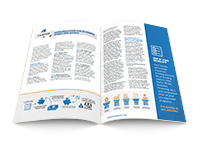Explaining ROBS to Your CPA & Attorney
It’s not uncommon for experienced tax professionals to be unfamiliar with Rollovers for Business Start-ups (ROBS). We’ve put together key points about this small business funding option to help improve your communication with these professionals.
No explanation is needed if you’re working with Guidant’s Bookkeeping & Tax services as they’re the experts in the ROBS setup.
How to Introduce ROBS to CPAs & Tax Attorneys
Please feel free to share this information with your tax professional, business attorney, or anyone who helps operate your business:
A common question we hear from tax professionals about 401(k) business funding is, “Is this legal?” The simple answer is yes. Here’s why:
ROBS uses two prohibited transaction exemptions. One is in the Internal Revenue Code (IRC), while the other is from the Employee Retirement Income Securities Act of 1974 (ERISA). These exemptions allow the use of retirement funds as capital to start a new business or franchise without triggering a taxable event (causing a taxable distribution).
The ROBS Structure
The two exemptions that work together are IRC § 4975 (d)(13) and ERISA § 408(e). The IRC exemption states there is no prohibited transaction if the rollover falls within the ERISA exemption. The ERISA exemption is met appropriately if the rollover transaction meets various requirements for the acquisition or sale of Qualified Employer Securities (QES). If both requirements are met, the two exemptions work in tandem to make ROBS a legal transaction. Check out Chapter 1 of this guide to learn more.
The Rollover
Companies that specialize in setting up the ROBS structure, like Guidant Financial, assist each client with the setup of their new corporation and 401(k) plan. This ensures the structure is formed correctly and meets the IRC and ERISA exemptions. Although complex, these steps are typically completed in less than three weeks. Here’s how it works:

- A new business is established as a C Corporation.
- The new corporation creates a new 401(k) plan that can purchase private stock.
- Funds from an existing retirement account are rolled into the new 401(k) plan — without triggering a taxable distribution.
- The 401(k) plan purchases stock in the C Corp.
- The C Corp acquires or starts a business using funds from the stock purchase.
- The new business is debt-free and now cash-rich.
Ownership Structure
On behalf of the client, the new 401(k) plan purchases Qualified Employer Securities (a.k.a. stock in the company). This is what funds the business. The one-time fee the client pays to Guidant is a start-up cost for the business. The client receives a percentage of personal ownership in exchange for that start-up cost. The 401(k) plan is usually the majority shareholder, though the client can purchase more stock with personal, non-retirement funds.
Your client can provide a copy of their stock ledger if you’d like to review the ownership structure with them. They will have completed this stock ledger with their assigned Outside Counsel.
ROBS Requirements
For an in-depth look at the requirements of the Rollovers for Business Start-ups structure, read Chapter 1 of this guide. Here is a quick overview of the crucial elements:
C Corporation Status
Any company funded by ROBS needs to be a C Corp — not an S Corp. Your client should not elect to be an S Corp (in short, do not file a Form 2553).
Exclusive Benefit Rule / Bona Fide Employee
The person who rolls their retirement funds into the ROBS structure must be a bona fide employee of the business they’ve funded. The rule is somewhat vague, but to be safe, Guidant suggests the owner work at least 500 hours per year. These hours can be accomplished through sweat equity (any time spent working for the business, regardless of payment). Occasionally, owners will work without pay while they get their company off the ground. This still satisfies the bona fide employee requirement.
Adequate Consideration
The adequate consideration requirement simply states that the 401(k) plan can’t pay more than Fair Market Value (FMV) for additional stock in the company. This typically becomes an element of consideration when the client invests additional funds into the company beyond what they’re purchased using ROBS. When this occurs, a business appraisal is often required to determine the value of each share.
Bonding Requirement
Your client might question if they’re required to maintain a Fidelity Bond to protect their 401(k) plan. Sometimes, the way this ROBS requirement is written leads people to believe a bond isn’t required if there’s only one owner; this is not the case. Any plan that purchases QES must be bonded. The Form 5500, a staple of 401(k) plan administration, specifically asks if a plan has an active bond. Answering no to this question can trigger an audit.
Pre-Qualify Today!



















